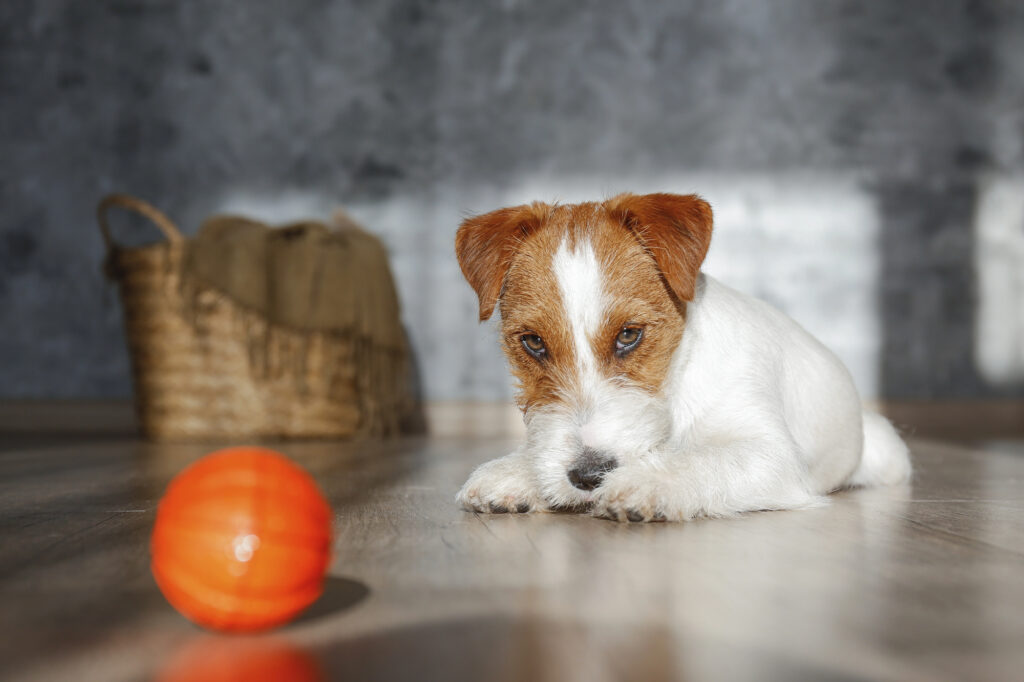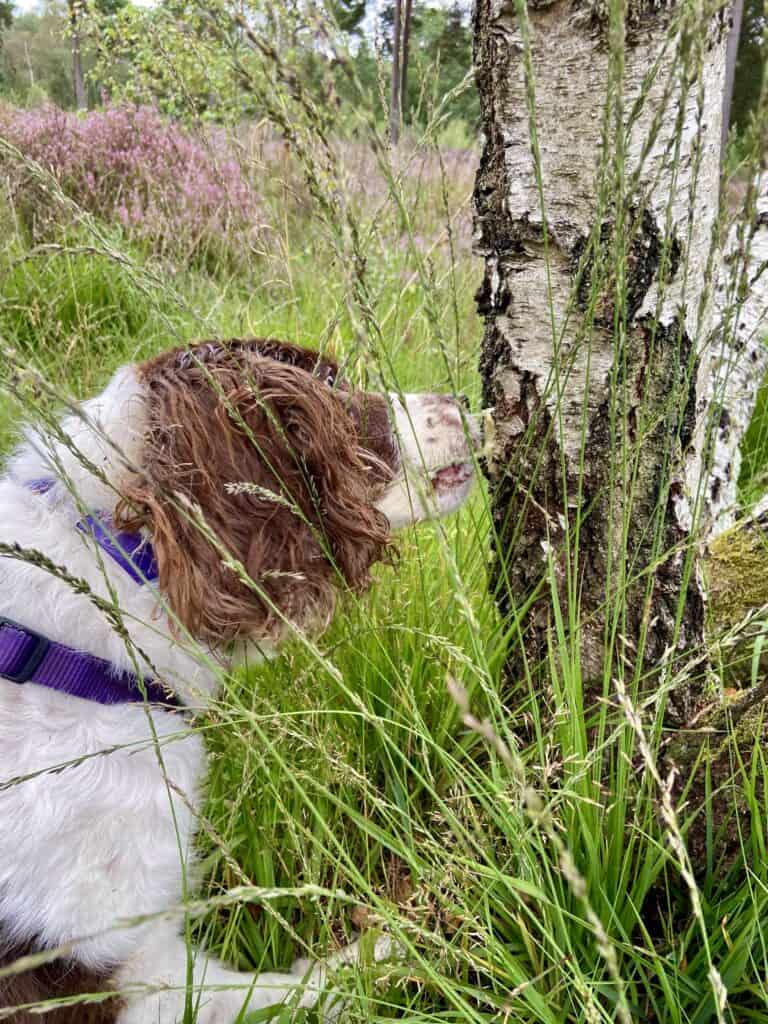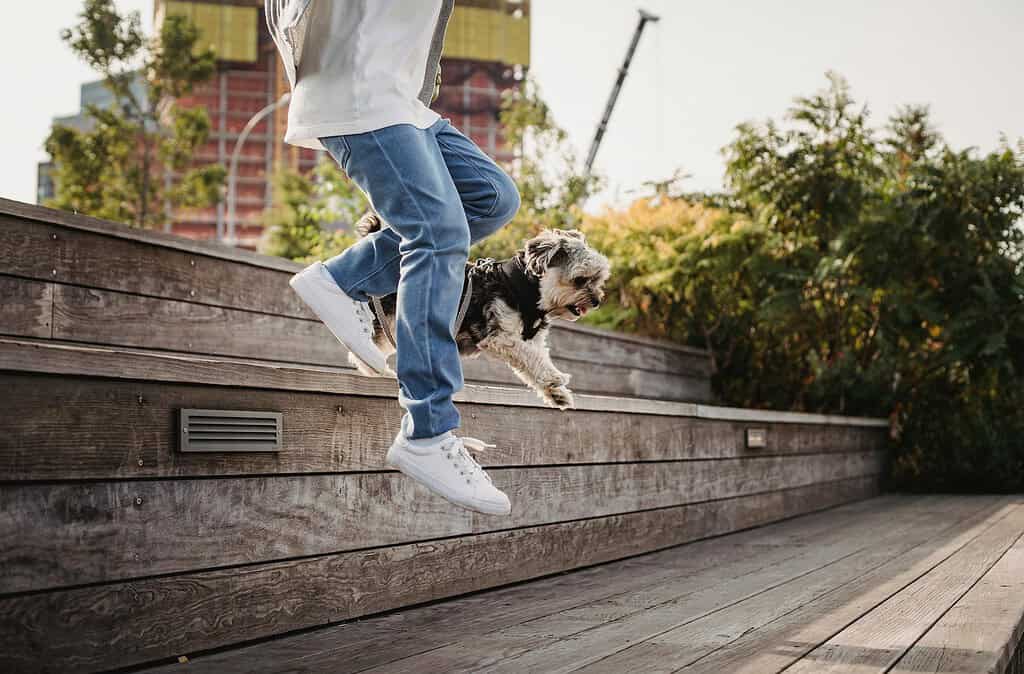If your dog overreacts to some situations, or shuts down and gets stuck, it’s normally because they are worried or afraid.
Boosting your dog’s confidence can help handle uncertainty better, meaning they react or freeze far less.
Increasing confidence isn’t always straightforward, but it’s absolutely possible.
Why Some Dogs Lack Confidence (And What You Can Do)
Early experiences
Dogs born in poor conditions tend to lack confidence. If the breeder didn’t provide age-appropriate stimulation and learning opportunities, those puppies miss out on developing the coping and problem-solving skills they need to navigate the world.
Socialisation
It isn’t the amount of exposure alone that matters. It’s being exposed to situations and stimuli that have good, safe outcomes that is important. It’s easy to over-face your puppy accidentally if you are just chasing a numbers game.
Instead, exposure needs to be positive, safe, and under your puppy’s control. That’s what helps them grow into confident adults.
Genetic tendencies
Some dogs are always going to be more nervous than others, even if they had the best start and stellar socialisation experiences. That doesn’t mean we can’t influence things so that they are the most confident they can be.
However, a dog whose genetics sway them to be more cautious than cavalier may never be as confident in ambiguous situations as a dog who has a genetic tendency towards confidence, even if that dog had a poorer start in life.
Bad experiences
Dogs, like humans have a natural tendency towards negative bias. That is, that negative experiences tend to be remembered for longer and have a more significant impact on learning than good experiences. For some dogs, just a few negative events can dramatically shape their view of the world.
The 6 Key Foundations of a Confident Dog
Predictability
Dogs who know how to access their reinforcers will be more confident navigating the world. Predictable environments and reliable outcomes help them feel safe.
Having strong default behaviours or chains of behaviours can also create predictability when the environment isn’t. This can help your dog anchor themselves when the situation is more ambiguous.
Success
Repeated successes breed confidence. It feeds into the predictability of a situation because your dog is able to anticipate good outcomes for themselves. History tells them that good things happen much of the time and that their own behaviour allows them to access those good things.
Choice and Control
Having control over your environment is essential for wellbeing. Dogs that know that they can opt out at any time and that their owner will respect and honour that will have more confidence than a dog that has no control over their life. Allowing a dog to opt out means they can also opt fully in and become an active participant rather than a passive mannequin.
Positive Reinforcement
Which really plays into predictability. Interestingly, research shows that dogs trained with both punishment and rewards tend to be more anxious than dogs trained with just one or the other. Why? Because ambiguity is stressful.
A dog who can’t predict if their behaviour will earn a treat or a telling off, they can’t feel safe. Since I’m not about to suggest we train our dogs with punitive methods (ever), we’re left with the best option: using positive reinforcement.
Resilience
This is the secret sauce. Resilience is what lets your dog bounce back from stress or uncertainty.
What is Resilience (And Why It Matters)?
Resilience is the ability to bounce back or recover from stress, fear or frustration. It allows a dog (or person) to face an uncertain situation without being overwhelmed.
Confidence doesn’t mean being fully comfortable with all situations that may ever occur in life. It’s more to do with the ability to cope with some discomfort in a healthy way.
Resilience allows us, and our dogs, to process something unexpected or unfamiliar or startling without the need for reacting or shutting down.
How to Build Resilience in Dogs (Even if They’re Anxious or Reactive)
Positive Experiences After Stressful Moments
When I work with clients, I call this “Feed the Unexpected”. We can’t affect the startle response – it’s an unconscious reaction and some dogs have larger startle responses than others. But we can influence what happens after. I like to do that by raining treats from the sky when something unexpected happens.
Gradual Exposure to Novel Situations
You can’t flood your dog and expect them not to drown. Instead, you need to keep them in the shallow end of the pool while they learn how to get their face wet before allowing them to wade into deeper waters where they can learn to swim. It’s important to let them go back to the shallows or get out of the pool completely at any time so they can recover before they go back in.
Opportunities for Problem Solving
Part of resilience is knowing you have skills to deal with situations as they come. And there’s some evidence that dogs feel good after problem solving. A low stakes way to help your dog build some skills is to set them challenges at an appropriate level and let them solve it themselves.
This could look like the usual food puzzles, or it could be scent work, either formal or things like scatter feeding across a wider area or hiding food or toys around the garden. In fact nosework has been shown to increase dogs optimism, probably because it taps into their natural instincts and lets them be independent while doing it.
It doesn’t even have to be something you cook up, you can take advantage of situations as they arise.
For instance, Talyn, one of my previous dogs, used to love holding tennis balls in his mouth. That or a Kong. He had obviously learned in his previous home that if he dropped them, someone would throw them for him.
So he tried that here – only he inevitably dropped it somewhere awkward, like under the sofa, making it inaccessible.
Then he’d bark at it, pause for a second to look at whatever human was nearby and then bark again. Clearly he’d learned that people are for fishing tennis balls out of tight spots.
Only…. I wouldn’t be doing that.
Mainly because it happened every few minutes, and I was working. And also because his strategy of barking and looking for a human to help was his go-to strategy for pretty much everything. I wanted him to be a bit more independent.
So I stopped everyone from fishing out the ball for him. We’d still help a bit at first – moving furniture or encouraging him to get the ball himself.
But over time, we helped less and less. Eventually, we only stepped in when it truly was inaccessible.
And it worked.
This transferred to other situations, too.
While we’d always step in when he genuinely needed help, we wouldn’t just do things for him. And so he learned to do more things for himself – and he became less frustrated and more resilient as a result.

Strong Relationship with Their Owner
You should always be a safe place for your dog. The safe home base from which they explore the world. When your dog knows they can trust you to advocate for them, to be their voice and their safety net, they feel bolder venturing out into the world – because they know you’ve got their back.
Signs Your Dog’s Resilience is Growing
- Faster recovery after setbacks or reactions
- Less frustration, or persisting longer with challenges
- More curiosity, less avoidance in new situations
- Disengaging from stressors rather than fixating
- Fewer or less intense reactions to stressful events
How to Build Your Dog’s Confidence: Practical Ways that Work
Safe Learning Opportunities
Confidence grows best in low-pressure environments. Avoid throwing your dog into overwhelming situations when they don’t have the skills to navigate it. They need to feel secure and safe, not threatened. Use:
- Positive reinforcement strategies only.
- Errorless learning techniques.
- Opt-out options at all times.
- Calm, low-stakes training sessions.
Set Up Exploration Opportunities

- Sniffaris
- Let your dog lead you around the neighbourhood
- Different textured surfaces
- Use as part of a free work exercise
- Have them around the home
- Allow your dog to explore different surfaces out and about
- Metal steps or bridges
- Cobbled areas
- Low brick walls
- Food puzzles
- Use at meal times or during day
- Scattering food works too
- Make your own snuffle mat, or snuffle ball
- Searching or scent work
- Can be a great way of introducing new experiences like
- Encouraging them to put their head into a box to access the find.
- Through or under objects to follow the scent
- Having objects brush their sides as they work through a narrow gap.
- Climbing up on (safe) surfaces to access their find.
- Can be a great way of introducing new experiences like
Teach specific skills for stressful situations
Teach skills that can help dogs regulate their emotions.
- Emergency “move away” cue
- Disengaging from stressor
- Relaxing in new places, or around activity
- Taking a deep breath
Support Don’t Force
Avoid pushing your dog into situations hoping they’ll get used to it – they won’t. It’s more likely they’ll be overwhelmed and less able to cope next time.
- Always allow your dog the option to opt out
- Learn their body language
- Step in when needed
- Check they are opting in as an active participant, not just tolerating or shutting down.
Play
- Tug, flirt poles, silly games you make up together, it doesn’t matter.
- Movement helps regulate stress
- Helps you learn their preferences
- Strengthens your bond together
- Let them win often!
Winning isn’t just fun – it’s confidence-boosting. Letting your dog succeed in play shows them that their efforts pay off, which builds optimism and persistence.
Troubleshooting: When Confidence-Building Stalls
Pushing or rushing things
Go at your dog’s pace. Rushing through things is counterproductive and won’t help your dog build confidence.
Inconsistency
Take a look at whether you are unconsciously falling back to punishment when things get stressful. Check you are consistent in reinforcing the behaviours you want to nurture.
Unclear Paths to Reinforcement
If your dog doesn’t know how to access their reinforcers in a situation then it leaves room for frustration or anxiety to creep in. Practise routines with low distraction environments before trying them when the stakes are higher.
Expecting Linear Progress
Linear progression is a myth. Learning just doesn’t happen like that. It’s completely normal to have setbacks or bad days.
- Keep data so you can track general trends
- Celebrate wins, even the tiny ones.
- Did your dog recover more quickly today?
- Did they take a treat in a stressful situation?
- Did they choose to check in with you instead of barking?
Grow Your Own Resilience (and Your Dog’s Too)
Confidence isn’t about pushing your dog—it’s about helping them feel safe enough to grow. When we give our dogs the skills, support, and space to build resilience, they surprise us with what they’re capable of.
Are you having your own stress response and frozen because you don’t know where to start?
I’ve got you.
Get in touch to talk about how I can help you build your dog’s confidence—and your own.
Or sign up for my newsletter, Behaviour in Bloom, for gentle, practical tips delivered straight to your inbox.

